国际财务管理第一章
- 格式:ppt
- 大小:52.50 KB
- 文档页数:15

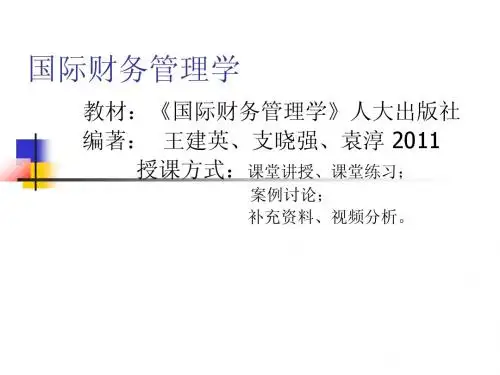
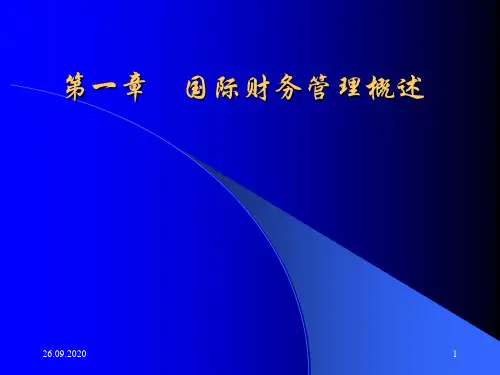

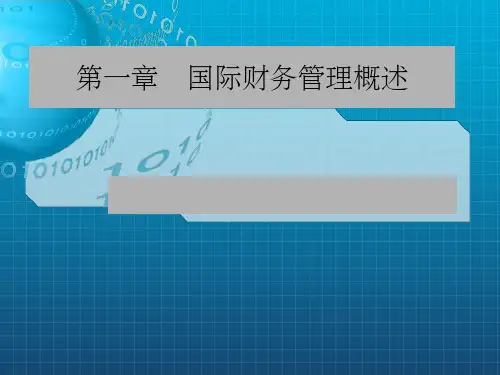
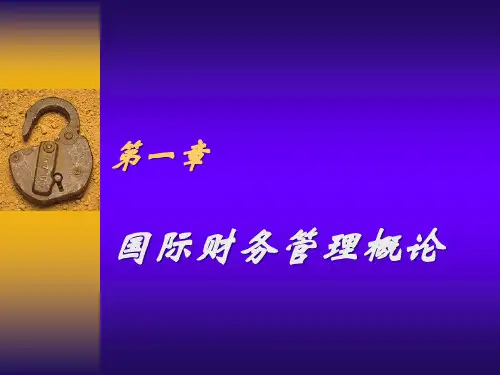

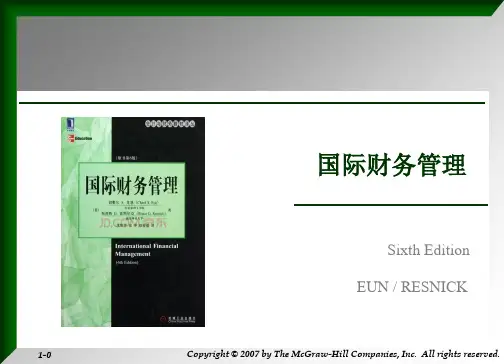



第⼀篇国际财务管理基础 第⼀章总论 第⼀节国际财务管理的概念 ⼀、什么是国际财务管理? 财务管理: ①财务活动→筹资→投资→营运资⾦→利润分配→财务预算。
②财务关系→与债权⼈、政府部门、供应商、员⼯等之间的关系。
国际财务管理→站在“国际企业”⾓度 1.国际企业:⽣产经营活动超越国境 跨国公司(是级组织形式) 国际企业的内涵>跨国公司的内涵 跨国公司标准(P2) (1)由两个或两个以上国家的企业组成(2)通过产权联结 (3)实⾏“全球战略” 2.国际财务管理的内容(P4) (1)理财环境 (2)外汇管理风险:⼀国货币贬值有利出⼝,不利进⼝;⼀国货币升值不利出⼝,有利进⼝。
第⼀节国际财务管理的概念 2.国际财务管理的内容(P4) (1)理财环境 (2)外汇管理风险:⼀国货币贬值有利出⼝,不利进⼝;⼀国货币升值不利出⼝,有利进⼝。
(3)国际筹资管理:低风险、低成本、获取所需资⾦。
(4)国际投资管理 (5)国际营运资⾦管理:存量管理、流量管理。
流动资⾦-流动负债=营运资⾦ (6)国际税收管理:使整个企业集团税赋最低。
(7)其他内容 ⼆、国际企业利益相关者(P15) 利益相关者标准:(1)对企业有投⼊;(2)对企业有收益; (3)承担企业的风险。
1.企业所有者:(1)经营决策权(间接);(2)享有剩余收益权; (3)承担风险。
2.企业债权⼈:(1)还本还息(税前);(2)合同中保护性条款(维权); (3)承担风险⽐企业的所有者⼩。
3.企业的职⼯ 4.政府:通过税收、⽆偿强制。
第⼆节国际财务管理的⽬标 三、国际财务管理的⽬标(P7) 两个⽬标: 1.股东财富化:股东利益、股票价格化。
2.企业价值化:在“全体利益相关者”的⾓度。
股东财富化: 股票价格化(P11) 优点:(1)考虑了时候价值;(2)考虑了风险价值; (3)克服了短期化;(4)直观。
缺点:(1)只适合于上市公司; (2)股市上影响股票价格的因素具有多样化;(3)只强调股东的利益。
Chapter 1 Managing Finance in Foreign Subsidiaries: An OverviewI. Learning objectives (教学目的)After studying this chapter, students should be able to:1)Identify the main goal of the MNC and potential conflicts with that goal.2)Describe the key theories that justify international business.3)Explain the common methods used to conduct international business.II. The arrangement of this chapter (教学安排) (3 课时)III. Important and difficult points (教学重、难点)Important points:1)the main goal of the MNC2)the key theories of international businessDifficult points:1)cost-benefit evaluation for purely domestic firms versus MNCsIV. The content of this chapter (教学内容)Goal of the MNC•The commonly accepted goal of an MNC is to maximize shareholder wealth.•Financial managers throughout the MNC have a single goal of maximizing the value of the entire MNC.Conflicts with the MNC Goal•Subsidiary managers may be tempted to make decisions that maximize the values of their respective subsidiaries.Impact of Management Control•The magnitude of agency costs can vary with the management style of the MNC.• A centralized management style reduces agency costs.• A decentralized style gives more control to those managers who are closer to the subsidiary’s operations and environment.Theories of International Business❶Theory of Comparative AdvantageWhen a country specializes in some products, it may not produce other products, so trade between countries is essential. This is the argument made by the classical theory of comparative advantage. Specialization by countries can increase production efficiency.❷Imperfect Markets TheoryThe markets for the various resources used in production are “imperfect.”The real world suffers from imperfect market conditions where factors of production are somewhat immobile. There are costs and often restrictions related to the transfer of labor and other resources used for production. There may also be restrictions on transferring funds and other resources among countries.❸Product Cycle TheoryAccording to this theory, firms become established in the home market as a result of some perceived advantage over existing competitors. A firm is likely to establish itself first in its home country because information about markets and competition is more readily available at home. As a firm matures, it may recognize additional opportunities outside its home country.(The international product life cycle on transparency 10)International Business Methods❶International trade involves exporting and/or importing.❷Licensing allows a firm to provide its technology in exchange for fees or some other benefits.❸Franchising obligates a firm to provide a specialized sales or service strategy, support assistance, and possibly an initial investment, in exchange for periodic fees.❹Firms may also penetrate foreign markets by engaging in a joint venture (joint ownership and operation) with firms that reside in those markets.❺Acquisitions of existing operations in foreign countries allow firms to quickly gain control over foreign operations as well as a share of the foreign market.❻Firms can also penetrate foreign markets by establishing new foreign subsidiaries.International Opportunities•Investment opportunities¤The marginal returns on MNC projects are above those of purely domestic firms since MNCs have expanded opportunity sets of possible projects from which toselect.•Financing opportunities¤MNCs can obtain capital funding at a lower cost due to their larger opportunity set of funding sources around the world.•Opportunities in Europe¤the Single European Act of 1987¤the removal of the Berlin Wall in 1989¤the inception of the euro in 1999¤the expansion of the European Union•Opportunities in Latin America¤the North American Free Trade Agreement (NAFTA) of 1993¤the removal of investment restrictions•Opportunities in Asia¤the removal of investment restrictions¤the impact of the Asian crisis in 1997-1998Exposure to International RiskInternational business usually increases an MNC’s exposure to:exchange rate movements,foreign economies and political risk.。
第一章国际财务管理导论【本章目标】通过本章的学习,要求理解并掌握国际财务管理的概念、特点、形成与发展阶段,以及国际财务管理的内容体系。
早在2005年,世界500强企业而中的90%以上已在中国投资。
面对众多跨国公司在我国的激烈角逐,越来越多的国内企业意识到仅仅在国内市场上的成功并不等于长期有利可图,过分依赖国内市场一定会落伍。
如果不主动参与到国际经济的链条中,最后的结果只能是勉强生存甚至被淘汰出局。
而这一切对于企业的财务管理活动意味着什么?首先,企业管理者的目光必须具有全球性。
与之相应,企业财务管理的目标也必须适应这种改变,在内容和层次上要求更加丰富,因为跨国公司多级的组织层次和巨大的环境差异使得公司本身所存在的委托代理问题变得更加严重和复杂,财务管理目标的制定和落实需要更多权衡。
其次,企业面临的风险和机会增加。
各国不同的经济状况和货币政策导致不同的税率、利率和货币软硬程度发生差异,企业筹资、投资面临更多的选择机会;货币币值本身的波动也给企业经营活动增添了更多的风险和可能的收益机会,企业财务管理的内容大大增加。
最后,企业内部的财务分析和业绩评价会因企业的全球化战略安排而更需慎重,分析和评价更多的需要从企业的全球利益出发。
第一节企业的国际化进程从广义上讲,国际企业是指任何超出本国界限从事商业活动的公司,包括各种类型、各种规模的参与国际商务的企业。
跨国公司是国际企业发展的较高阶段,是企业国际化程度较高的组织形式,通常被认为是最具有代表性的国际企业。
一、企业国际化的历史沿革1、国际贸易早在17世纪,伴随产业革命产生的国内和国际分工,一些国家的企业就己经产生了以商品贸易为主的国际经营活动。
只是到了17世纪以后才有真正意义上的国际贸易出现。
特点是:①贸易的地域已经发展到世界上的大部分国家和地区;②在时间上,商品的交换已经不是间断的,而成为资本主义再生产中的一个环节;③在资本主义的生产方式上,一切产品都是商品,相当大的一批商品参加国际贸易;④19世纪70年代,国际金本位制形成,标志着世界市场的形成。